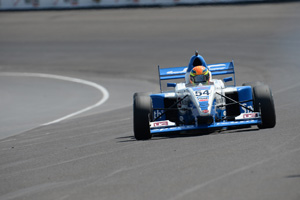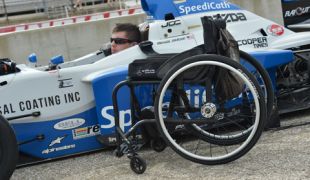Open-wheel racing’s first paralyzed driver has his eyes set on IndyCar fame
Mazda Road to Indy, Pro Mazda, Pro Mazda commentary — By John Lingle on June 23, 2014 10:11 amJohnson uses a set of hand controls that are similar in name only to those used by disabled drivers in passengers cars. The packaging constraints of a purpose-built race car and the rigors that hard racing place on the parts and pieces mean that the system he uses, now in its fifth iteration, is both proprietary and constantly evolving.
“This car that we have is all custom-built,” Johnson says. “You can’t really get the controls I need, and the way that these open-wheel cars are, every car is different as far as what it will allow you to do. The generic hand controls that you can find on the market for a street car just aren’t practical in an actual race car, and most of the reason for that is that the street hand controls aren’t designed for hard, intense racing. They aren’t made to withstand that type of abuse. The design work that we did, a lot of it was through JDC. My dad and I think of ways to make it work better for me, and then JDC tries to design that.
“In the Pro Mazda car (Johnson’s current race car), the way we have the hand controls set up is that the braking is done by the entire steering shaft being pressed in, which in turn presses a rod onto a modified brake pedal. It’s not perfect yet, but it’s much better than the USF2000 car or the Skip Barber car systems we used.
“The shifting in this car is different than anything else that I’ve ever had, and no one else has this type of paddle shift in Pro Mazda. It’s manufactured by Crawford in North Carolina. It’s still got some bugs, but it’s working pretty well. We’re down to fine-tuning it from a software perspective now.
“Getting it to the point that I like and keeping it within the series requirements is a fine line. For instance, we can’t downshift any faster than what the actual manual sequential lever can, and it’s a fine line getting to that point. I don’t think we’re there yet, and there’s a lot more time to be spent on that part of it. It’s got to get better, and we’re going to get it there.
“The clutch is a lever that is down by my left hand. I grab that lever with my left hand, then reach over and work the throttle with my right hand. We don’t need to use the clutch other than to stop and go. We want to change the clutch, but it’s a costly add-on. The clutch that they’re looking at is similar to the ones IndyCar uses.
“There are definitely ways to make the controls easier for me, but it’s all a matter of finding the resources to do it and the funding. The more funding you have, the better toys that you can get. Of course I would like it to be better, but I have what I have and I am making the best of it.”
Racers generally make up or lose a large portion of their lap times in the braking zones of a racetrack, and everyone with knowledge of the hand control setup agrees that Johnson’s system is far from perfect in that regard, putting him at a decided disadvantage.
“Michael has a huge hill to climb using hand controls,” Andersen explains. “In a race car braking is a very crucial part of lap time, and when you have to do all of your heavy braking with your arms instead of with your legs, it’s a disadvantage. But he’s at the top of the charts on occasions. He hasn’t yet pulled out a podium, but it will not surprise me at all when he does.”
“There are some areas where he is always going to give up, especially in the braking areas, due to how he has to do it as opposed to someone else,” Church agrees. “The optimal braking procedure in an open-wheel car with downforce is a very strong initial application that then trails off as the downforce and speed come off of the car.
 “Well, he’s pushing on the steering wheel and the G-forces are pushing him forward, so the natural tendency is for his body and arms and everything to continue to push harder on the wheel, which is opposite of what he needs to be doing, which is pulling back. It’s an unnatural reaction, and then you throw in the other stuff that he has going on with downshifts and such. He’s doing with two hands the same amount of things that others are doing with two hands and two feet. He’s a hand short right now.”
“Well, he’s pushing on the steering wheel and the G-forces are pushing him forward, so the natural tendency is for his body and arms and everything to continue to push harder on the wheel, which is opposite of what he needs to be doing, which is pulling back. It’s an unnatural reaction, and then you throw in the other stuff that he has going on with downshifts and such. He’s doing with two hands the same amount of things that others are doing with two hands and two feet. He’s a hand short right now.”
Ever the racer, Johnson is focused only on what he can control, and he already has ideas in place to improve the system for next year.
“I think we will make some more changes next year, probably with the braking system,” he says. “It’s not a problem on the ovals, but it is on the road courses where you have the load in the corners and you want the wheel to return back. Sometimes when I go into the corner I have to actually pull back on the wheel to get it to release the braking load, not to mention the fact that everyone naturally pushes in on the steering wheel in the corner.”
All of the mental and physical difficulties this system poses can take a heavy toll on Johnson’s body, but he manages to keep a positive outlook rather than focusing on the negatives.
“My upper body is in very good shape because of all of this,” he says. “My seatbelts have to be so tight at the beginning of the race that they actually hurt me since we know that they will loosen up during the race. I can tighten them a little bit while I’m driving, but the tighter I can be belted in, the better. The seat also helps me to stay stable better so that I can focus on the other 30 things I have to deal with in a corner.”
Johnson’s racing results have improved as he has progressed on the Mazda Road to Indy, and his promotion to Pro Mazda this year seems to have suited him especially well. Johnson has run some of the fastest laps at several of the tracks that the series has competed at this year, and he should be a factor on the tight Reliant Park layout in Houston.
“This year, the car fits me better,” he explains. “It lets me get a better seat, which supports my lower hip area up to my ribs and really supports me, which is a lot different than the seat in the USF2000 car.
“This year hasn’t really gone the way that I wanted it to go either, but I’m showing people what I have. I’ve shown good speed on the time charts, but I just haven’t been able to make it happen in the races yet. We’ve had some issues with our hand controls as well as far as shifting and braking. It’s a totally new system, so no one really knows what to do or what will work.
“We’re finding these things out, and unfortunately they are only happening during the races right now, but the entire JDC crew has been really supportive of what I’ve been doing and it’s been really fun. They’re learning this as they go too, so this has been a learning experience for everybody, I’d say.”
No stranger to hardship at this point in his life, Johnson is working hard to improve his skill set and the cars so that he can run consistently at the front of the field. Today, he relays a set of goals that are based in reality but still have that racer’s twist.
“I just want to be like any other driver,” he says. “I want to race, have fun, and win.”
Betting against him has been a losing proposition so far. Doing so now would seem ill-advised as well.
Tags: Dan Andersen, JDC Motorsports, Michael Johnson







